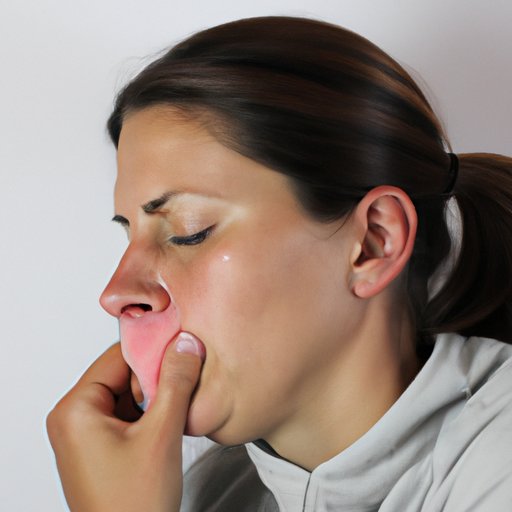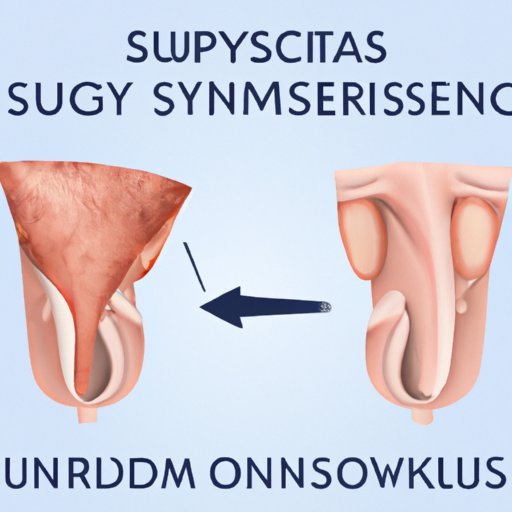
Introduction
If you’re experiencing nasal obstruction, a deviated septum may be the culprit. This condition occurs when the nasal septum, the thin wall that separates the nostrils, is shifted to one side. A deviated septum can cause breathing difficulties, snoring, and other uncomfortable symptoms. Fortunately, there are several ways to fix a deviated septum and improve your overall quality of life.
Five Effective Ways to Fix a Deviated Septum: A Guide to Better Breathing
When it comes to fixing a deviated septum, there are several options available. Here are five effective ways to treat this condition:
1. Septoplasty Surgery
Septoplasty is a surgical procedure that involves straightening the nasal septum. During this procedure, a surgeon will make an incision in the septum and remove any excess bone or cartilage that is causing obstruction. This surgery can be done under general or local anesthesia and typically takes 30-90 minutes to complete.
Benefits: Septoplasty is considered the gold standard for treating a deviated septum and has a high success rate in improving breathing function. The recovery process is usually quick, with most patients able to return to normal activities within a week or two.
Drawbacks: Septoplasty is an invasive procedure that carries some risks, such as bleeding, infection, or complications with anesthesia. It can also be expensive, with costs ranging from $3,000 to $10,000 depending on location and severity.
2. Balloon Sinuplasty
Balloon sinuplasty is a minimally invasive procedure that involves inserting a small balloon into the sinus passages and inflating it to widen the airway. This technique can be used to treat a deviated septum as well as sinusitis and other related conditions.
Benefits: Balloon sinuplasty is less invasive than septoplasty and requires no incisions or general anesthesia. Many patients experience immediate relief from nasal obstruction and have minimal downtime after the procedure.
Drawbacks: This procedure may not be suitable for severe cases of deviated septum, and its effects may not be as long-lasting as septoplasty. It may also not be covered by insurance and can cost between $5,000 and $10,000 out-of-pocket.
3. Nasal Steroid Sprays
Nasal steroid sprays are a non-invasive way to reduce inflammation in the nasal passages and improve breathing. These medications are available over-the-counter or by prescription and work by reducing swelling and opening up the airway.
Benefits: Nasal steroid sprays are safe and easy to use, and they often provide fast relief from nasal obstruction. They are also relatively affordable and may be covered by insurance.
Drawbacks: These sprays may cause side effects such as dryness, irritation, or nosebleeds. They may also take several days to start working and may not be effective for everyone.
4. Nasal Dilators
Nasal dilators are small devices that can be inserted into the nostrils to help widen the airway. These devices work by applying pressure to the nasal passages and preventing collapse during inhalation.
Benefits: Nasal dilators are cheap and easy to use, and they can provide immediate relief from nasal obstruction. They may also be useful for snoring and sleep apnea.
Drawbacks: These devices may not be effective for severe cases of deviated septum, and they may cause discomfort or irritation if not properly fitted. They may also need to be replaced regularly and may not be covered by insurance.
5. Acupuncture
Acupuncture is a traditional Chinese medicine technique that involves inserting thin needles into certain points on the body to promote healing and relieve pain. This technique may also be useful for alleviating nasal obstruction and other symptoms of deviated septum.
Benefits: Acupuncture is a non-invasive technique that carries few risks and may have additional benefits such as stress relief and improved sleep.
Drawbacks: Acupuncture may not be effective for everyone and may require multiple sessions to see results. It may also not be covered by insurance and can be expensive.
From Symptoms to Solutions: How to Treat Deviated Septums at Home
If you’re not ready to undergo surgery or are looking for ways to supplement your treatment, there are several home remedies you can try to alleviate the symptoms of a deviated septum. Here are some of the most effective:
1. Nasal Irrigation
Nasal irrigation, also known as a neti pot, involves rinsing the nasal passages with a saline solution to clear congestion and reduce inflammation. This technique can be done using a neti pot or a squeeze bottle and can provide fast relief from nasal obstruction.
2. Humidification
Adding moisture to the air can help alleviate dryness and congestion in the nasal passages. Using a humidifier at home can be a simple and effective way to improve breathing and reduce nasal irritation.
3. Steam Inhalation
Inhaling steam can help open up the airway and reduce inflammation in the nasal passages. You can achieve this by using a steam inhaler, taking a hot shower, or holding your face over a bowl of hot water.
4. Aromatherapy
Some essential oils, such as eucalyptus or peppermint, may promote respiratory health and provide relief from nasal obstruction. Adding a few drops of these oils to a diffuser or inhaling them directly can be a helpful adjunct to other treatments.
5. Lifestyle Changes
Making simple changes to your lifestyle can also help alleviate the symptoms of a deviated septum. These may include getting regular exercise, drinking plenty of water, avoiding triggers such as smoking or pollution, and getting adequate rest and stress relief.

Understanding Deviated Septum Surgery: What You Need to Know
If you’re considering septoplasty or other surgical options for correcting a deviated septum, it’s important to understand the process and what to expect. Here are some key factors to consider:
Types of Surgery
Septoplasty is the most common type of surgery for a deviated septum, but there are other options, such as rhinoplasty or turbinate reduction. Your surgeon will help determine the most appropriate type of surgery based on the location and severity of the deviation.
Risks and Benefits
As with any surgery, there are risks and potential complications associated with fixing a deviated septum. These may include bleeding, infection, breathing difficulties, or changes in the appearance of the nose. However, for many patients, the benefits of improved breathing and reduced symptoms far outweigh these risks.
Recovery and Aftercare
Recovery from septoplasty typically involves a few days of rest and limited activity, as well as avoiding certain foods or medications that may interfere with healing. Your surgeon will provide specific instructions for aftercare and may recommend follow-up visits to monitor progress.
Natural Remedies for a Deviated Septum: A Comprehensive Guide
If you’re interested in supplementing your deviated septum treatment with natural remedies, there are several options available. Here are some of the most effective:
1. Vitamins and Supplements
Certain vitamins and supplements, such as vitamin C or omega-3 fatty acids, may help reduce inflammation and promote respiratory health. Consult with a healthcare professional before starting any supplement regimen.
2. Herbal Supplements
Herbs such as ginger, turmeric, and licorice root have anti-inflammatory properties and may be useful for reducing nasal obstruction and other symptoms of deviated septum.
3. Acupuncture
As mentioned earlier, acupuncture may be useful for promoting healing and reducing symptoms of deviated septum.
4. Chiropractic Care
Chiropractic adjustments may be helpful for relieving tension and improving spinal alignment, which can in turn improve respiratory function and alleviate symptoms of deviated septum.
The Link Between Allergies and Deviated Septums: Tips for Relief
Allergies can exacerbate the symptoms of deviated septum and make breathing difficulties worse. Here are some tips for managing allergies and reducing nasal obstruction:
1. Avoid Triggers
Identify and avoid common allergens such as pet dander, pollen, or dust mites. Keep your home clean and free of dust and mold.
2. Use Allergy Medications
Over-the-counter allergy medications such as antihistamines or decongestants can help reduce symptoms and alleviate nasal obstruction.
3. Immunotherapy
Immunotherapy, also known as allergy shots, can help reduce the frequency and severity of allergic reactions, which may in turn reduce symptoms of deviated septum.
Overcoming Obstacles: Living with a Deviated Septum and How to Fix It
Living with a deviated septum can be frustrating, but there are steps you can take to improve your quality of life. Here are some action steps to take:
1. Schedule a Consultation
If you’re experiencing symptoms of a deviated septum, the first step is to talk to a healthcare professional. They can help determine the severity of your condition and recommend appropriate treatment options.
2. Explore Treatment Options
Consider all available treatment options, including surgery, home remedies, and natural remedies, and choose the ones that work best for you. Don’t be afraid to ask questions and get a second opinion if necessary.
3. Communicate with Your Doctor
Keep your doctor informed of any changes or improvements in your symptoms, and work together to adjust your treatment plan as needed.
Conclusion
A deviated septum can be a frustrating condition that interferes with your breathing and overall quality of life. However, with the right treatment plan, you can overcome this obstacle and breathe easier. Whether you choose surgery, home remedies, or natural remedies, taking action and seeking treatment is the first step towards better health and wellbeing.





